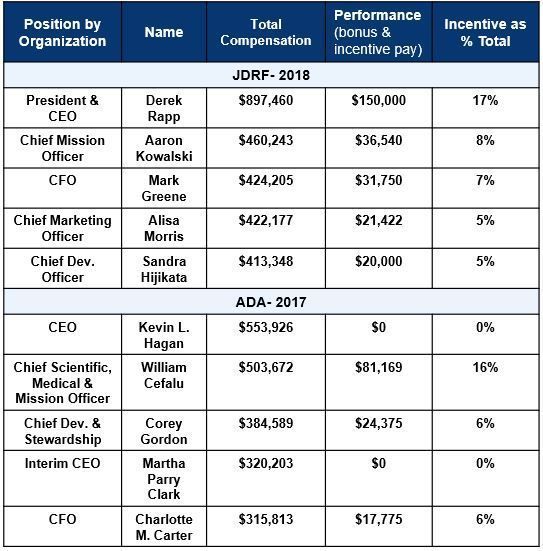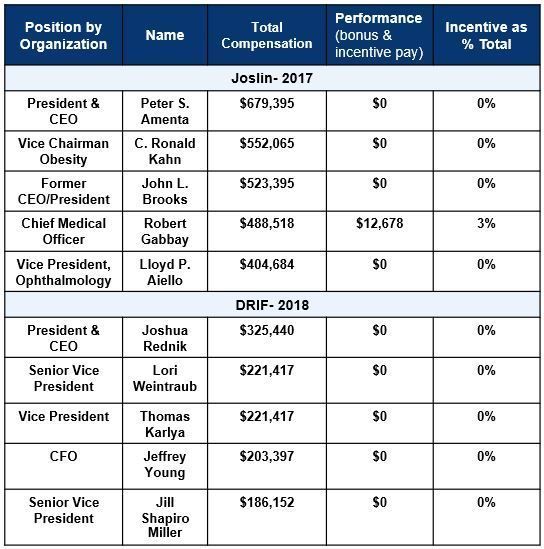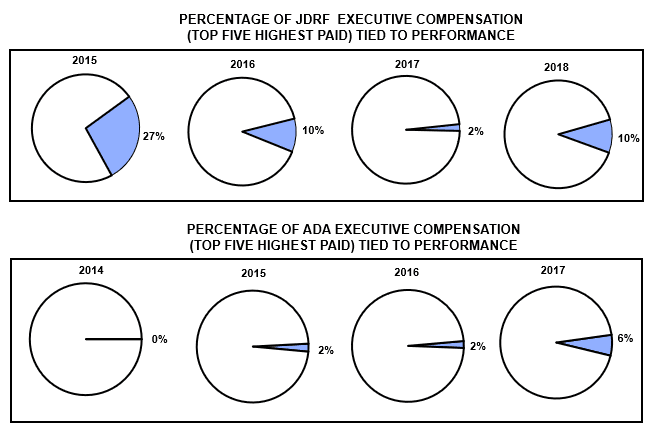Summary Points:
- The majority of the ADA and JDRF executive compensation is fixed and guaranteed.
- Performance-based pay remains only a small fraction of overall compensation.
- Compensation is NOT linked in any direct way to material progress toward a T1D cure.
- Donors and other financial supporters have no mechanism to influence compensation policies.
- The JDCA argues the Board of Directors for the ADA and JDRF should take action to tie compensation directly to performance toward cure progress. This would focus executives and be well received by the donor community.
- 'Say on pay', as discussed later in the report, provides valuable opportunities for non-profits to improve accountability and drive executive performance.

This is the eighth annual review of executive compensation for the top diabetes non-profits. The review focuses on the ADA and JDRF, the largest diabetes fundraising organizations, but also includes data for Joslin and the Diabetes Research Institute Foundation (DRIF), two other notable diabetes funding organizations we periodically cover. A full overview of compensation for the top five executives at each organization is detailed in Appendix A. All data is sourced from the publicly available IRS Form 990.
JDRF's most recently filed 990 includes data from July 1, 2017, to June 30, 2018. ADA's most recent 990 includes data from January 1, 2017, to December 31, 2017. The 2018 990 form has not been posted to the ADA website as of publication.
Executive Pay Compensation is Not Tied to Results
The most important finding of this report is that very little executive compensation is tied directly to performance. The ADA and JDRF executives are paid the majority of their compensation regardless of whether they meet their main objectives or make progress toward a cure for T1D. This differs from most for-profit companies, where the majority of executive pay is directly tied to performance. In addition, a number of other non-profits, such as the American Heart Association (AHA) use metrics and goals related to both fundraising and mission goal progress to incentivize executives. In 2018, 46% of the American Heart Association’s CEO compensation was tied to performance in 2018.
By leaving incentive pay off the table, the JDCA believes the ADA and JDRF are missing out on an effective way to prioritize the central goal of each organization's mission— finding a cure for T1D. See Appendix C for a year by year comparison of executive compensation tied to performance at JDRF and the ADA.
High Pay = High Accountability
As stated above, the high compensation level for diabetes non-profit executives places them in the top 1 percent of all earners in the U.S. CEOs of larger organizations, as measured by the amount of money the organization raises per year, are generally paid more. Competitive executive compensation is important because it helps to attract and retain top talent. However, the JDCA believes it is also important to hold these highly-compensated executives to a level of accountability and performance commensurate with their salary. As long as compensation remains untied to performance, executives will remain unaligned with donors who want resources allocated to finding a cure over all else.
Say on Pay: An Opportunity for Nonprofits?
Executive compensation levels at the largest diabetes non-profits are determined behind closed doors by a committee within the board. The Board of Directors does not publicly communicate any aspect of strategy or rationale for compensation levels and the average donor is given no input or transparency into the decision.
The same approach is followed by most for-profit companies but is actively being challenged by shareholders who want input on the remuneration of executives. This is commonly referred to as "say on pay." When a corporation has a say on pay provision, shareholders are allowed to vote on specific aspects of executive compensation, such as pay structure, base pay, and most commonly, bonus amounts.
The JDCA believes a "say on pay" model could deliver T1D non-profit donors many of the same benefits it provides for-profit company shareholders, such as increased transparency and executive accountability. While the mechanics of adopting a 'say on pay' model would take some work to implement, the long-term benefits to both donors and the board may be well worth the effort.
APPENDIX A: COMPENSATION OF THE TOP FIVE EXECUTIVES (COMBINED) FOR JDRF, ADA, JOSLIN, AND DRIF


APPENDIX B: COMPARISON OF EXECUTIVE COMPENSATION AT OTHER NON-PROFITS

APPENDIX C: PERCENTAGE OF THE ADA AND JDRF EXECUTIVE COMPENSATION TIED TO PERFORMANCE

